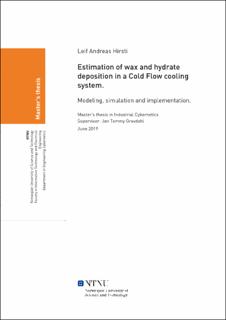| dc.contributor.advisor | Gravdahl, Jan Tommy | |
| dc.contributor.author | Hirsti, Leif Andreas | |
| dc.date.accessioned | 2019-10-31T15:01:06Z | |
| dc.date.issued | 2019 | |
| dc.identifier | no.ntnu:inspera:35771502:23547217 | |
| dc.identifier.uri | http://hdl.handle.net/11250/2625659 | |
| dc.description.abstract | Voks- og hyrdratavleiring har vært et problem i petroleumsbransjen en stund. EMPIG AS har utviklet et Cold flow kjøling system. Det er et 300 m langt rørsystem plassert inne i en container for å ha et kontrollert område hvor voks og hydrater kan bygge seg opp, for så bli varmet opp av en robotarm. EMPIG har hatt problemer med finne lokasjonen av voksavleiring og tykkelse i dette kjøling systemet. Dette er for å spare ressurser slik at de slipper å varme opp hele røret.
I denne masteroppgaven har det blitt utviklet en algoritme for å estimere vokslokasjon og tykkelse. Det startet med å modellere og simulere tre 150 m lange strømlinjer og plassere voks på 50 m, 75 m og 100 m. Vokstykkelsen ble satt til 0.5 mm og 1mm. En tilstandsrommodell av strømlinjen ble laget med trykk og strømning tilstander med \texttt{n} noder. Dette ble implementert i MATLAB. Tilstandsrommodellen ble sjekket for stabilitet og om den er observerbar. Iterativt fikk hver kontroll volum et mindre areal for å tilsvare vokstykkelse på 0.5mm og 1mm. Etter dette så ble et diskre Kalman filter utredet og implementert. Resultatet viste seg den beste estimering var i midten av strømlinjen. Diskusjon og framtidig arbeidet har vært utredet der eventuelle feilkilder og hva EMPIG og andre aktører må forbedre før man kan teste estimeringen i fullskala. Konklusjonen er at voks og hydrat avleiring og tykkelse kan bli estimert, men man gjøre noen modifisering for at modellen skal bli lik kjøling systemet. | |
| dc.description.abstract | Wax and hydrate deposition have been a major problem for the petroleum industry for some time. EMPIG AS have created a Cold flow cooling system to make sure that wax and hydrate deposition are removed in a 300 m pipeline to fit inside a container. They use a mechanical arm to find and heat up wax and hydrates. They have had a problem finding wax and hydrate location and thickness. This is to save resources and avoiding heating the whole pipeline.
In this thesis, an algorithm to estimate the location and wax thickness has been created. Starting with a model in COMSOL Multiphysics to make three models of a 150 m flowline and simulate pressure profile with wax deposition at 50 m, 75 m and 100 m. Furthermore, creating state-space equations of pressure and flow states to later be implemented into MATLAB has been done. Stability and observability were areas that also had to be covered. The flowline was divided into \texttt{n} control volumes and was iteratively added a wax deposition of 0.5mm and 1mm. To estimate the location and thickness was done with a discrete Kalman filter. The results showed that estimation in the middle gave a result with the smallest error. Discussion and future work were conducted about possible errors and what EMPIG and others must do for getting a better estimation. In conclusion, it is stated that the estimation for location and thickness works but need further work to become accurate enough for EMPIG’s cooling system. | |
| dc.language | eng | |
| dc.publisher | NTNU | |
| dc.title | Estimation of wax and hydrate deposition in a Cold Flow cooling system | |
| dc.type | Master thesis | |
